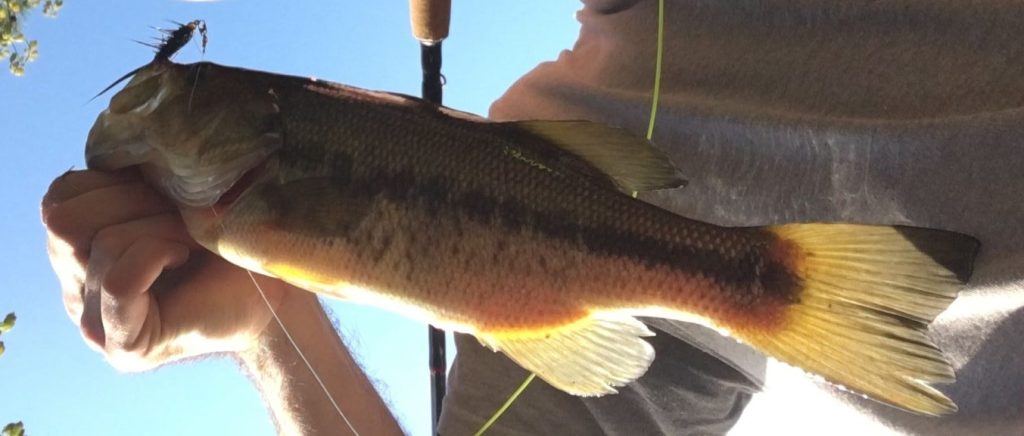
“Many men go fishing all their lives without knowing that it is not fish they are after.” Henry David Thoreau
Bass, as easy as they are to catch when they are “on,” can be discouragingly finicky. A cold rain, a few days of soaring temperatures, or a shift in the weather can shut them down faster than you might think.
When they’re in this sort of way, I’ve seen bass snub their noses at everything you can throw at them. Sight fishing bass in shallow water when they don’t want to strike is a course in frustration.
But there is one time of year when basically every technique works, every time, and that’s the spawn.
And in my area of the country, that time of year is coming up quickly.
In most of the country, when the water starts to get into the 55℉ to 65℉ range, largemouth bass come into the shallows to spawn. They fan out beds called “redds” which are basically round, crater-like nests into which they deposit their eggs and raise their fry.
These nests look like a series of craters on the lakebed near the shoreline, and when you see bass making these, you can be sure that the bite will be on very soon.
During the spawn, bass are intensely, irritatingly aggressive. Spawning bass eat little to nothing for those few weeks when they are guarding their redds – but they will try to kill anything and everything that moves.
Think of bass on their beds as aquatic bears with cubs. If it moves and gets close to their beds, they will attack and try to kill it.
Consequently, this aggression makes it fairly easy, in some cases, almost stupidly easy, to catch bass during the spawn season.
Here are my best bits of insight (not that you need them, anyone can catch spawning bass).
But good advice never hurts, right?
Go Shallow and Look for Beds

The spawn is the one time of year that you can guess bass will be holding shallow and you’ll be right 99% (or more) of the time.
All of the breeding bass will be in the shallows and fanning out beds where they will deposit their eggs and guard their fry for a few weeks until they’re on their own.
During this period they are unbelievably aggressive and, as I mentioned, will try to kill anything that gets too close to their beds.
How shallow the bass are will depend on the water temperature and the general topography of the lake. in very shallow lakes, bass might be making beds in 1 to 3 feet of water.
If it’s a deep lake with deep holes and a larger gradient between the colder temps and water shallows, bass might be spawning in water that’s closer to 10 feet deep, which is still comparatively shallow.
In the shallow impounded lakes around where I live, bass spawn in water that is, on average, between 2 and 6 feet deep.
The water around here is dark, stained cedar water, and the lake bottoms are usually muddy or covered in a bed of dark leaves from the previous fall.
This actually makes finding spawning bass easy to find as the redds stand out like sore, bright highlights against the dark lake bottom. They look like a bunch of sandy craters.
A trick I can offer you for finding spawning bass is to break out your polarized sunglasses (which you should be wearing anyway) and cruise along the shallows 100 to 300 or so feet off the shore.
When you find them, throw something at them and hold on tight because within a cast or two one of those bass is probably going to take you for a ride. I’ve actually had spawn time bass tow my canoe. It can happen to you.
Target Structure
Even though during the spawn you can reliably target fish that are bedded up in the shallows, not all of the fish are going to be there.
I don’t know the reason for this, but even during the spawn, some of the bass hang out around structure in deeper water. Although sometimes the structure is in shallow water, too.
Realistically, this isn’t just a spawn time technique because the truth is this tip works at literally every other time of year, except perhaps during the hottest and coldest days of the year.
But when you can find structure, you can find bass.
My point is don’t limit yourself to fishing the beds. At this time of year bass hunkered down around structure are just as cooperative as their love-mad counterparts.
So what should you look for?
Downed trees. Rock piles. Ledges. Docks. Pilings. Reeds. Clumps of grass. Lily Pads. Submerged weeds. Tree limbs overhanging the water. Any and all of these things can and will hold fish at most times of year, especially at spawn time.
If you need a break from the bass on the beds or if for some reason they’re not cooperating, give those redds a break and find the nearest structure. Throw whatever you have tied on at that clump of whatever-it-is and hang on.
Once again, my guess is the bass are going to take you for a ride.
Look for a Drop Off
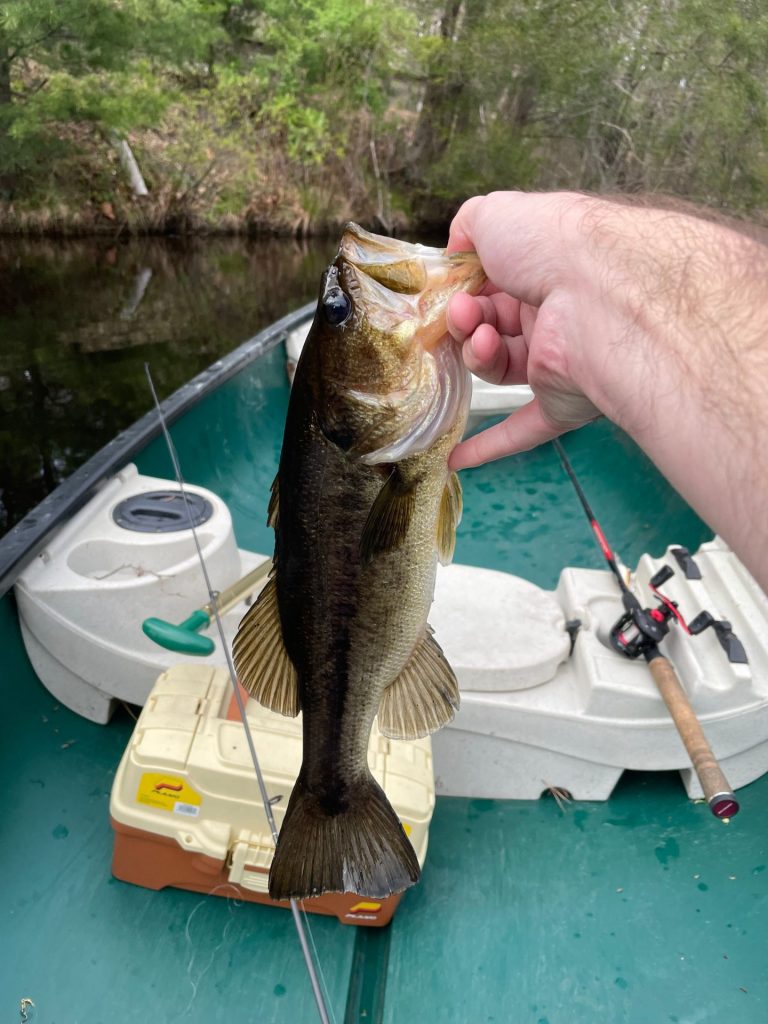
I have one more technique you can follow to help you find bass in the early spring, although I have to admit this one is not from experience but from talking to other fishermen.
The lakes I fish are mostly fairly shallow, but something I have noticed is that even during the spawn time, a lot of fish are still concentrated where the lake drops off a little bit.
I can’t remember which fisherman said this, but I once read something to the effect of “When I cast to the fish along the shore, I know that 90% of the fish in the lake are behind me.”
It is true, too, even during the spawn time. The problem is finding them.
Well, if bass aren’t responding to you (for whatever reason) even during the spawn season, take a break from the shallows, paddle a bit further away from the shore till you’re in slightly deeper water, and drop a bass jig.
Let it hit the bottom and bounce it off the bottom for a ways. If the other bass are spawning and you get that jig in front of a fish you will probably be rewarded for it.
Techniques:
Now that you have three key areas to target fish during the spawn time, all you need to know is what to tie on.
Good news: in my experience, literally every conceivable bait and technique will work for bass during the spawning season.
There are some that perform better than others, though. These are some of my favorite baits to throw at bass during the spawn, along with techniques to accompany them.
Soft Baits

Just like at most other times of the year, soft baits are an excellent bait option for target spawning bass in the spring.
But what are the best patterns and techniques? That’s a bit harder to answer since they all seem to perform well.
One of my favorite ways to fish for spring bass with soft baits is to fish a weightless plastic, Texas rigged.
The weightless plastic won’t sink too fast, which will keep it suspended in shallow water for longer, giving angry bass a longer look at it – and plenty of time to get madder and madder, until they strike.
I love fishing Power worms, YUM dingers, Zoom Magnum and Trick worms, and weightless curly-tail grubs in this fashion.
Cast them over the beds, let them sit for one to five seconds, then twitch-and pause them – emphasis on the pause, most strikes come when the bait is effectively motionless.
Another great technique is to cast weightless soft plastics over the beds and, after the initial pause, to sharply snap the rod tip a few degrees up or to the side. This makes the plastic dart erratically from side to side, almost as if you are “walking the dog” under the surface. It is highly effective in spawning bass.
Fishing weightless plastics is not the only way to go, though. There are plenty of other rigs and techniques you can use.
You can also rig plastics as a trailer on a jig. It’s not my go to technique, but you can rig a plastic as a trailer, throw it onto a bass’s bed, and hop it along the bottom. You can rig worms like this, but I prefer shorter plastics as the shorter the trailer is, the less you’re likely to experience short strikes that will just pull the plastic off the jig, and not result in a hookup.
A good middle ground is the classic Jika rig. If you don’t have any and don’t want to pay nuts tackle shop prices, learn how to jury-rig a Jika rig right here. I’ve written about it before.
The great thing about the Jika rig is that the weight moves independently of the hook and plastic, resulting in very free, likelike movements from the lure.
Throw one of these over the beds, and just like a jig, skip it back to the boat along the bottom. Be ready for a strike when you’re letting the rig sit on the bottom. I feel that’s when most of them come.
Another great soft bait technique, that is also an excellent technique at all times of year, is to throw a curly tail grub on a jighead. Rigged on a light jighead, either ⅛ or even 1/16 of an ounce, a two or three inch plastic grub can be worked anywhere from right at the top of the water column, through the middle zone, and even hopped across the bottom.
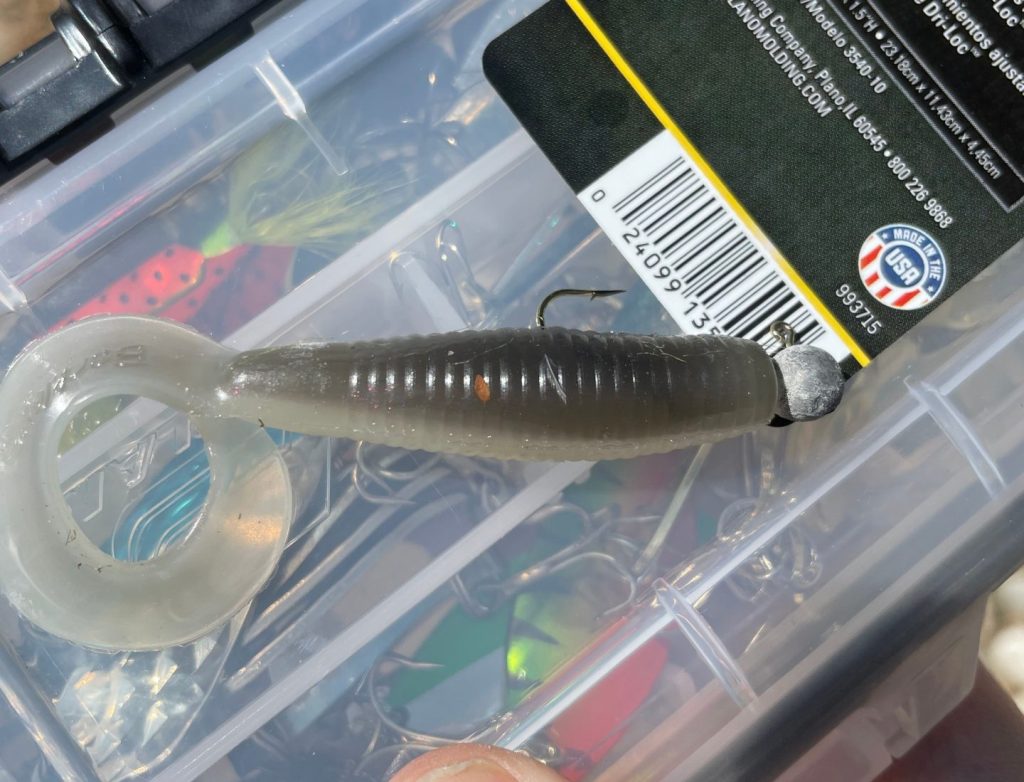
The jighead-rigged curly tail grub is therefore the most versatile artificial lure in the book, period. That’s probably why it was named the best lure of all time by Field and Stream back in the day. Believe me, I tried to find the original article and link to it because it was a great read. I loved it, back when Field and Stream was good. But as you may know, that once respectable font of outdoors wisdom has badly deteriorated.
Anyway, I’ll get off the soapbox. Rig a curly tail grub on a jighead, fish it this spring, and I nearly promise you will catch fish. Just give it a try. It’s the best lure out there.
I know I specifically called out YUM Dingers, Powerbait Power Worms, and curly tail grubs, but really, there are so many other plastic bait patterns that are effective at spawn time.
Other great options include swimbaits, creature baits, chunks and trailers, and lizards. Really, anything and everything works at this time of year.
Plugs
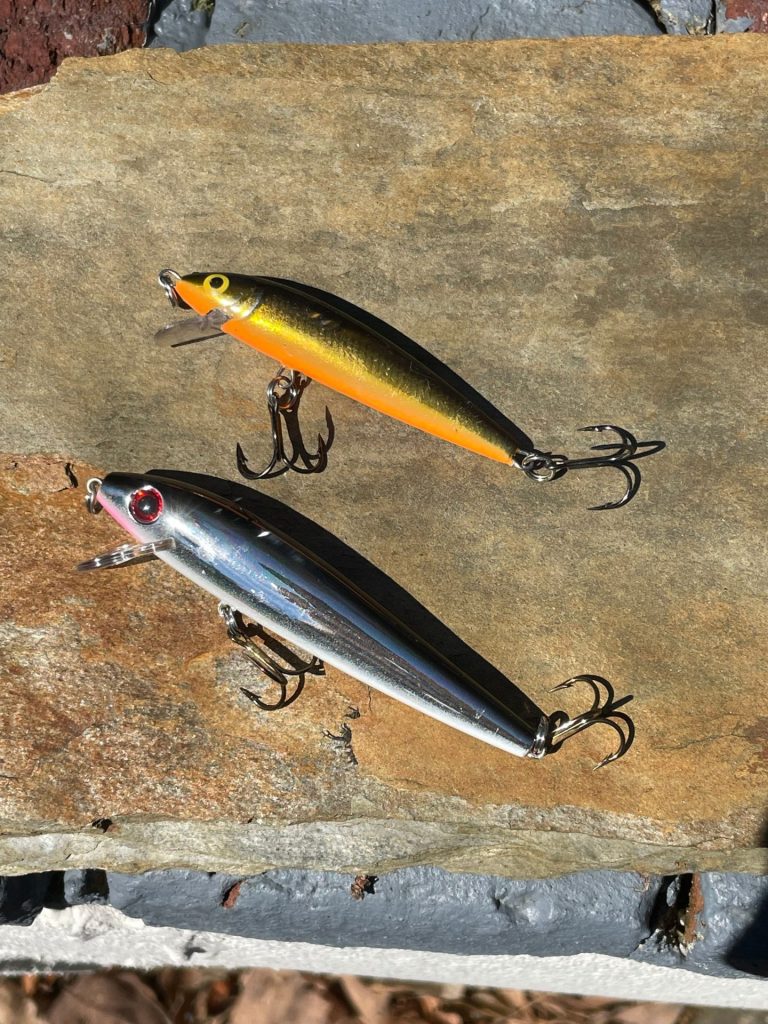
Plugs are also very effective at spring spawn time. I think that all sorts of plugs can be fished effectively, but my two favorite basic styles are crankbaits and neutral buoyancy stickbaits, like Rapala Husky Jerks.
The crankbait design – a big, fat plug that dives aggressively and floats back to the surface when paused – is very effective for a few reasons during the spawn.
One, they have a very large profile and usually produce a very wide wobble, which makes a big impressive, makes a lot of noise in the water, and creates a hell of a displacement. That all sounds like one of two things to a bass: a threat to the nest, or a dinner bell.
Either way, crankbaits like Bomber Fat Free Shad and Rapala DT Crankbaits are very effectively during spawn time. Since they dive deep, they can be fished in water down to like 15 feet, and since they float, if you get too deep, you can either hold the depth or pause to allow them to rise back through the water column.

Just like with plastics, you can fish a crankbait in a variety of ways during the spawn.
Probably the most effective technique to use during the spawn is to cast the crankbait into the shallows over a bed, let it sit till the ripples die away, then crank it down a foot or two, pause it, and twitch it back to the boat. Again, be ready for the strike on the pause.
Another effective technique is to cast it, and twitch it along the surface slowly like a wakebait. This makes a lot of noise and creates a stark contrast against the sky. It is also highly effective on spring bass.
The only thing I don’t prefer to do with a crankbait in the spring is burn it – and the only reason is that burning crankbaits in shallow water is a good way to lose a bunch of snags. Save burning for the stickbaits that run shallower.
In addition to crankbaits, I love to fish neutral buoyancy stickbaits like Rapala Husky Jerks in the spring. In fact, these might be my all-time favorite plugs to fish during the spawn.
The great thing about the Husky Jerk is that is stays in one place in the water column when it’s paused.
My favorite technique is to cast it over the beds, then twitch it down a foot or two, give it a long pause, and then intermittently twitch it back to the boat. This is my favorite technique and bass tend to take strong, full-bodied swings at Rapalas when they are fished over their beds in this manner.
Unlike crankbaits, however, you can burn Husky Jerks back to the boat during the spawn, since they don’t run too deep. Burning a plug is something I rarely do if ever, but during the spawn time, it works.
Just cast that Rapala over the beds, let it sit for a second, then let ‘er rip all the way back to the boat. Not my go-to technique, but bass are aggressive enough during the spawn that you’ll get a lot of reaction strikes.
As far as color and pattern, I like bright, flashy colors during the spawn because attention draws strikes. At other times of year, when fish are more shy, I’ll skip the bright colors and patterns, but sometimes during the spawn, firetiger patterns and bright silver and gold plugs get fish riled up – and they bite.
For a more thorough breakdown of the best ways to fish a Rapala lure, please see my previous blog on just that topic.
While I did specifically call out Rapala Husky Jerks and Bomber Fat Free Shad, there are tons of other great plugs to fish during the spawn. Some of these include Rat-L-Trap style sinking plugs, Rebel Value Minnows, Strike King Crankbaits, Rapala Original Floaters, and Jointed Rapalas. They all work just fine during the spawn.
Topwater: Poppers
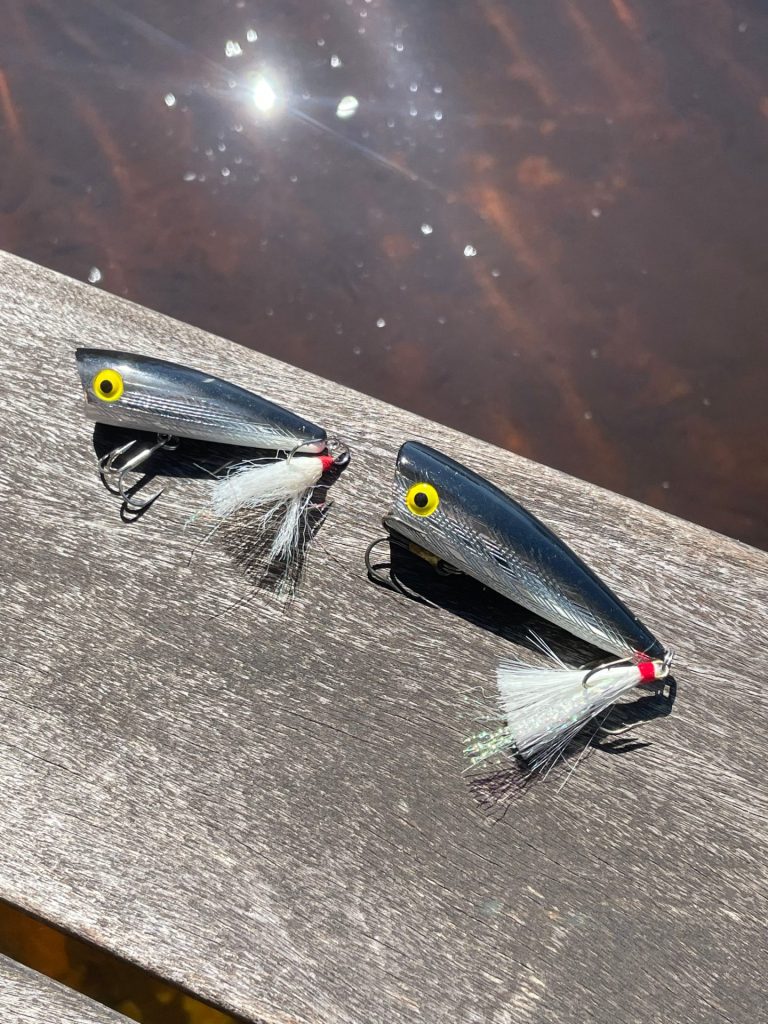
There are some bass fishermen that fish topwater just because they love the thrill of the strike. I must admit there are times when I crave that excitement, too.
But I have also to admit that when my goal is to put a bend in the rod, topwater is rarely my first choice.
Not during the spawn, though. During the spawn, I can say from experience, confidently, that one of the most effective ways to catch bass is with topwater lures.
My best piece of straightword advice?
Get a Rebel Pop-R. Color doesn’t matter. EIther tie it directly to your line or attach a snap swivel and then the lure.
Cast that Pop-R right over the top of a bass’s bed. Let the ripples die away, then wait two to three more seconds.
Snap the rod aggressively towards you to make the Pop-R splutter. Let it sit. Repeat. GIve it two to three pops, followed by long pauses.
The trick is to wait until you’re almost uncomfortable. That, more often than not, is when you’re going to get the strike.
Pop-Rs, for some reason, make bass absolutely mad during the spawn. Perhaps it is because they make so much noise. Perhaps it is because the presentation is so aggressive. Perhaps it is the fact that the lure stays conspicuously on the surface of the water throughout the entire presentation.
Either way, it almost always works for me, and probably 90% of the fish I’ve caught on the top came during the spawn time. Don’t be surprised if you get a bunch of pickerel, bluegill, and crappies in this manner while you’re targeting bass.
While my personal favorite topwater lure is a silver Rebel Pop-R, it is not the only effective topwater you can use in the spring.
I’ve also had a lot of luck with Heddon Zara Spooks. Tie one on, throw it over a redd, let it sit, just like a popper, and then jerk the rod tip to the side of the boat. The Spook will dart to one side. Let it sit, then jerk the rod again. The Spook will dart to the other side. This zig-zagging is called “walking the dog,” and it is highly effective.
Let the lure sit. Again, most strikes come on the pause.
These are my personal favorite topwater techniques – the nod goes to the Pop-R – but there are others.
Other fishermen do well with hollow body frogs. Toss them over the beds, or better yet, over a clump of weeds of lily pads, and twitch them, imparting long pauses. Bass will suck them down right quick, too.
Spinners
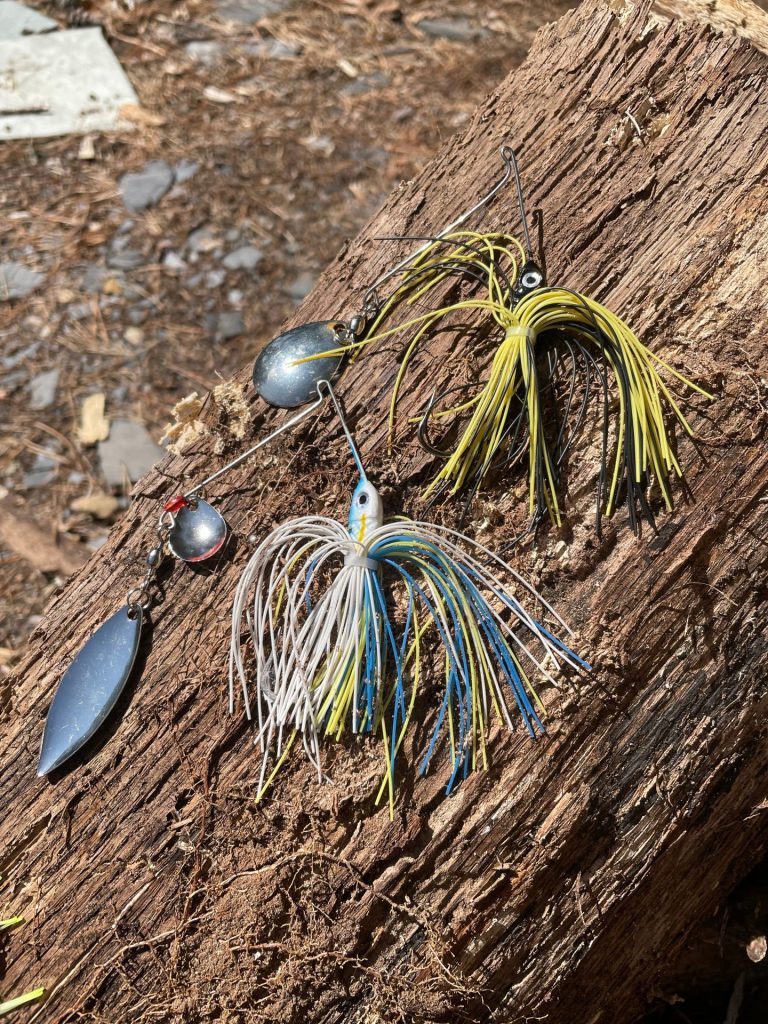
Spinner baits, both inline and buzzbait style, can be extremely effective on spawning bass and some anglers will actually tell you to tie these on first.
Why are they so effective? Well, a few reasons. The cast-and-steady retrieve nature that most fishermen employ while using them is fast and enables them to cover (“search”) a vast amount of water very quickly.
The other obvious reason is that spinners make a lot of noise and throw a lot of light. Both of these things get bass pissed and elicit strikes, making them extremely effective during the spawn.
Fishing spinners is easy, so easy it could be called dumb fishing. Spinners (all styles) are the only lures that I routinely fish a steady retrieve.
Just cast to a bed or structure, let the lure sink a few feet to the strike down, snap the rod tip to start the blade, then give it a nice, slow, steady retrieve, just enough to keep the blade turning.
If bass are particularly effective, speed up your retrieve a little. See what works best.
Again, all spinner types are effective during the spawn, including inline spinners, buzzbaits, and safety-pin style spinners.
As far as styles go, I personally prefer the french blade of the Mepps Aglia. It turns well at low speeds, can be worked both shallow and deep, and makes the most noise. Colorado blades are also effective. So are willow and Indiana blades, but they need to be worked more aggressively to keep turning.
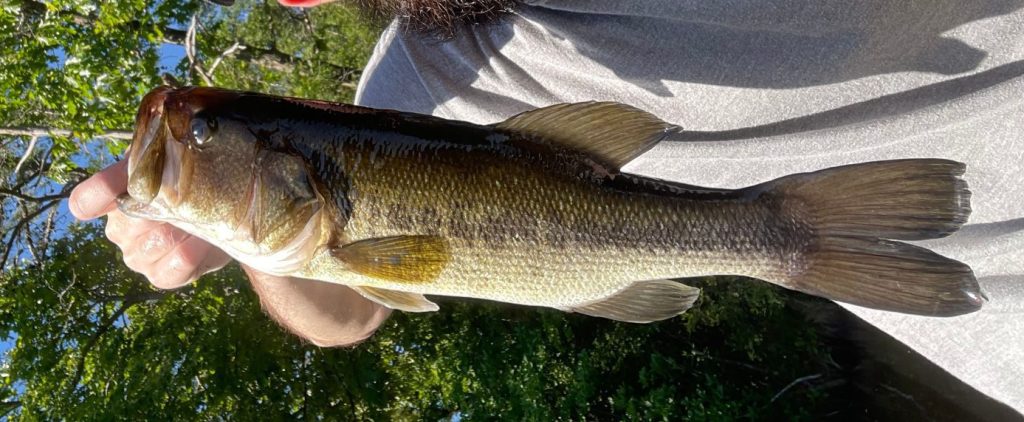
I like Mepps, Rooster Tails, and Panther Martins, but there are tons of other good spinners.
My best advice, though? Make your own spinners.
If you make your own, you’re guaranteeing fish will never have seen that specific lure before (not a huge deal during the spawn but still helpful) and most importantly, you’ll be slashing the per-unit cost of each lure, which will save you money.
Plus there’s no way to catch a fish like there is to catch one on a lure that you made. If you thought you loved the thrill of a bent rod and a tight line, just wait till you experience that on a bait that you made yourself.
Good luck, and tight lines.
~The Eclectic Outfitter